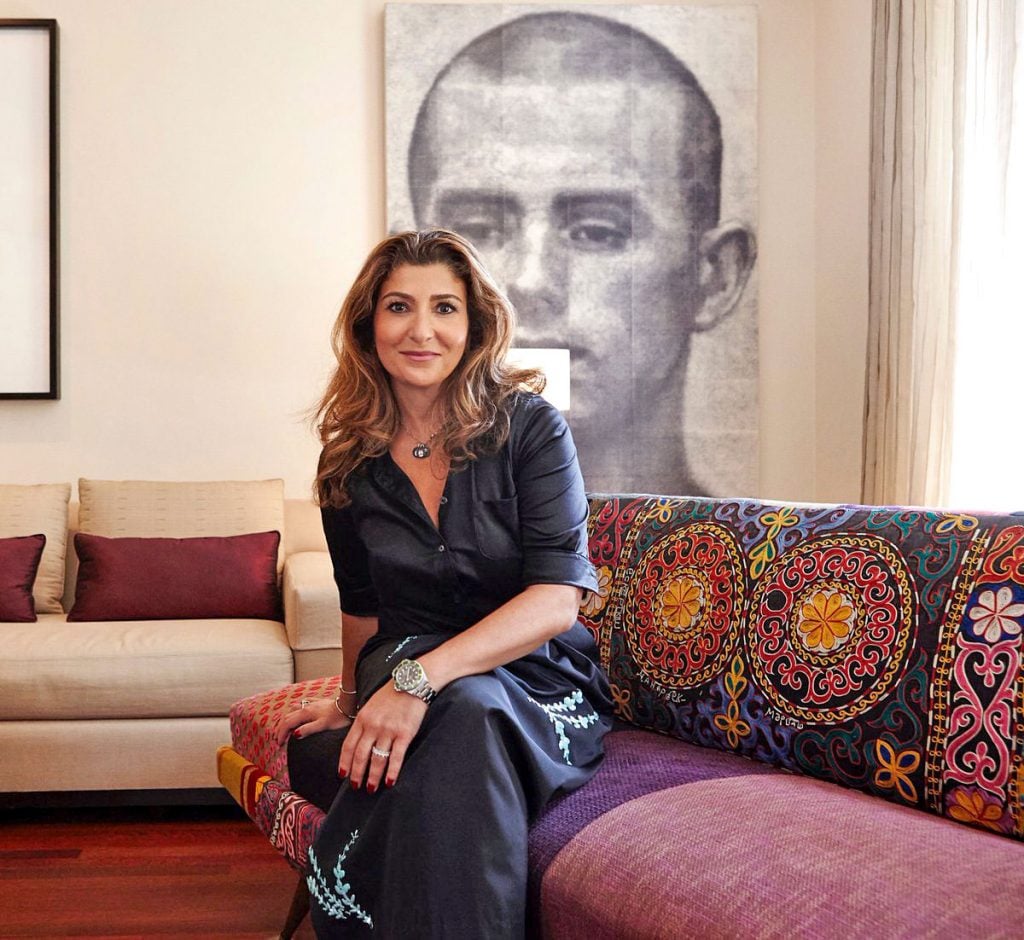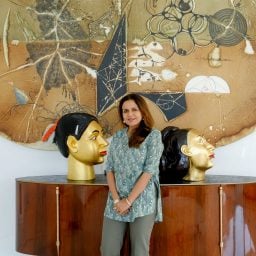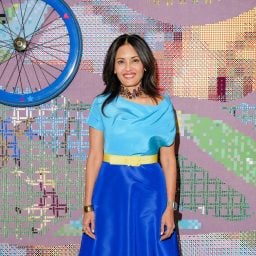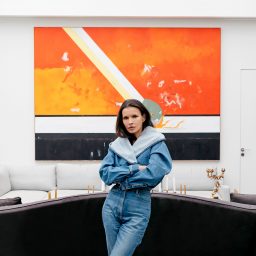In 2008, on her first trip to Iran since departing 30 years earlier, curator Roya Khadjavi was surprised to find a thriving arts scene in Tehran. So she quickly set about visiting studios and meeting with artists; she was heartened to discover that many of them, maybe most, were women. “I was inspired and energized,” she told Artnet News, “by the female strength, beauty, intelligence, talent, perseverance, patience, and humility all together.”
Khadjavi returned to New York vowing to help these artists connect with curators and collectors in the U.S. and around the world. She founded Roya Khadjavi Projects in 2014 and opened her first show, “Portraits: Reflections by Emerging Iranian Artists,” featuring the work of more than 25 contemporary Iranian artists. Many of them were women and all had been born after the Iranian Revolution of 1979.
The aim of the exhibition was to present the complexity of modern Iran through the prism of artists working within its borders or its diaspora, artists who created contemporary works by drawing on the country’s culture and history. “I wanted them to be able to make their living from their art,” said Khadjavi. “I wanted my efforts to remain vital and important, both for the artists and for the audiences I want to reach and educate.”
Recently, Khadjavi loaned several works to “Change Agents: Women Collectors Shaping the Art World,” a current exhibition at Southampton Art Center on Long Island, New York, spotlighting the collections of 14 women collectors. The loans include works by Arghavan Khosravi, Afruz Amighi, Bahar Behbahani, and Parastoo Ahovan—each with her own unique relationship with the artistic traditions of Iran.
As a philanthropist, meanwhile, Khadjavi has been influential in promoting Middle Eastern art at the Solomon R. Guggenheim Museum and Asia Society, both in New York.
We chatted with Khadjabi about her more-personal-than-most art collection, her very first purchase, and which artist’s work she wishes she acquired sooner.
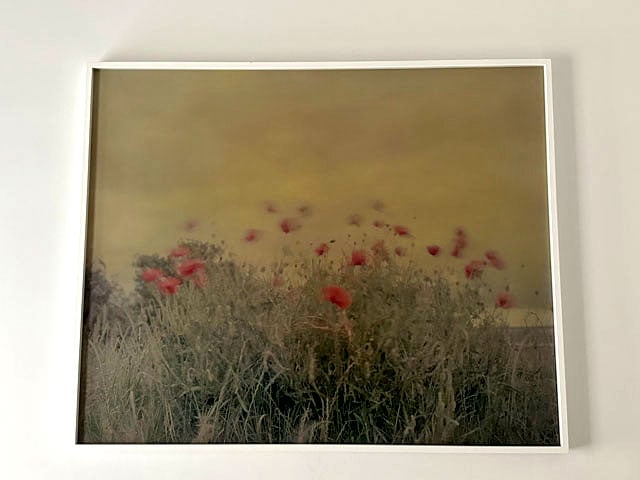
Ori Gersht, Untitled (Poppy) (2004). Courtesy of Roya Khadjavi.
What was your first purchase?
An Ori Gersht photograph of a poppy field on an English beach, which I gifted to my daughter. It was the first piece I collected when I was just starting to learn about contemporary art. A friend of mine who was an art consultant took me on many trips to galleries and museums so I could form an aesthetic. It was an impulsive purchase. I connected with it because it’s romantic.
What was your most recent purchase?
A painting by Atieh Sohrabi. I represent and showcase the work of Iranian artists in New York and international art fairs—and she’s one of them. She makes illustrations for books and videos, as well as paintings. She started by doing very small paintings on cardboard. She always sells out her gallery shows; I had to wait for my own piece.
Tell us about a favorite work in your collection.
One of my favorites is a large wall text in hand-poured glass by American artist Rob Wynne, one of the first works that I bought. I went to Rob’s studio about 20 years ago, saw this work, and bought it. It’s a very large work for someone who was a novice at collecting, but I really responded to it. It says “Chaste and Radical Fragile and Bizarre,” which is how [opera producer] Franco Zeffirelli described Maria Callas, who happens to be my favorite opera singer. The quote describes two sides of the same person. There’s also a portrait of her in the room, so it’s like an homage to Maria Callas at the entrance of my apartment.
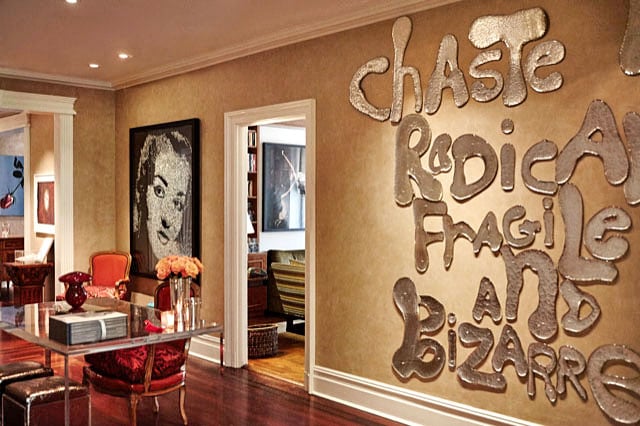
Vik Muniz, Maria Callas (2004) at left, Rob Wynne’s Chaste and Radical (2006) at right. Courtesy of Roya Khadjavi.
Which works or artists are you hoping to add to your collection this year?
A painting by African artist Wangechi Mutu. She started by doing these very small and enigmatic works on paper—it wasn’t clear if they were animals or humans. I should have bought her works much earlier, when they were just a few thousand dollars. Now they’re much more. I have a lot of portraiture in my collection and a lot of her work is figurative. I don’t have much space left in my home, but I love her work.
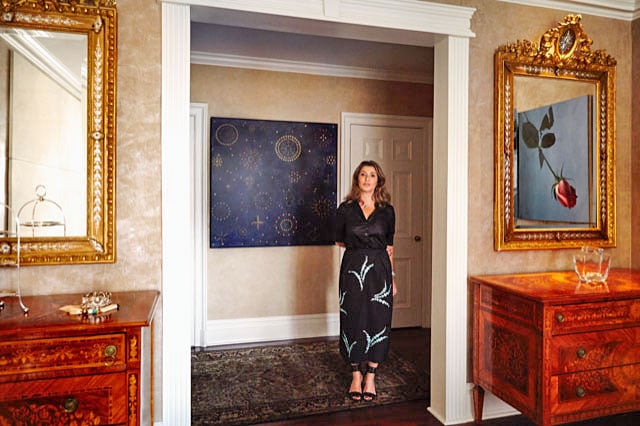
Roya Khadjavi next to Fred Tomaselli’s Phospena (1993). Courtesy of Roya Khadjavi.
What is the most valuable work of art that you own?
A work by Fred Tomaselli and one by Andy Warhol.
Where do you buy art most frequently?
From galleries and art fairs like Art Basel Miami, Frieze London, and Paris Art Fair. I also do Photo London and all the New York art fairs. Frieze London is my favorite, followed by the Armory in New York.
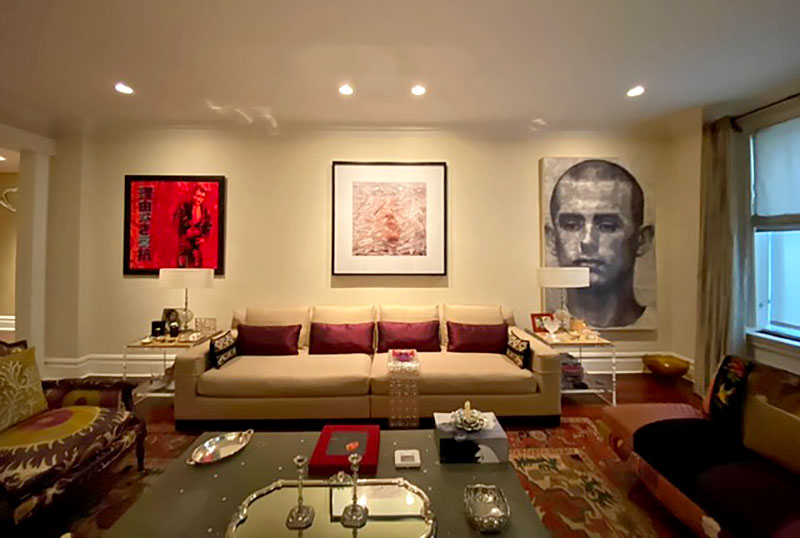
Left to right: A work on paper by Andy Warhol, a photograph by Marina Abramović, and a mixed-media piece by Y.Z. Kami. Courtesy of Roya Khadjavi.
What work do you have hanging above your sofa?
I have three: a work on paper by Andy Warhol, a photograph by Marina Abramović, and a 1996 mixed-media piece by Y.Z. Kami, an Iranian artist represented by Gagosian. The Warhol piece is a poster he made in the 1980s of James Dean in Rebel Without a Cause for the Asian market. It’s a unique piece, not an edition, that I purchased from the Andy Warhol Foundation. Marina’s photo is from a performance where she’s laying in a bathtub and crystals cover her body as she emerges. I found it striking because of the voluptuous red lips.
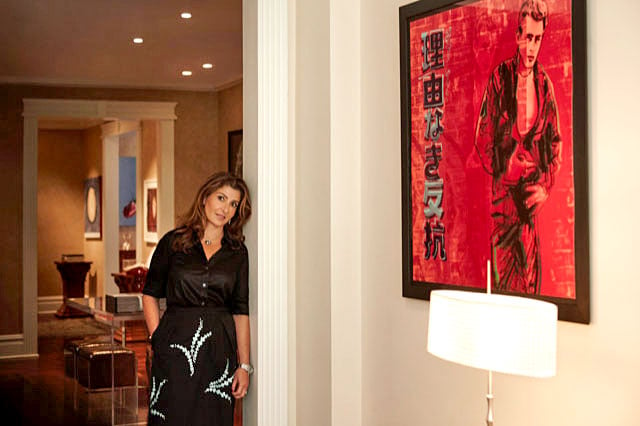
Roya Khadjavi with her Andy Warhol screenprint. Courtesy of Roya Khadjavi.
What about in your bathroom?
A photograph by Juergen Teller, which he made for a Marc Jacobs campaign. The woman with her legs up is Victoria Beckham.
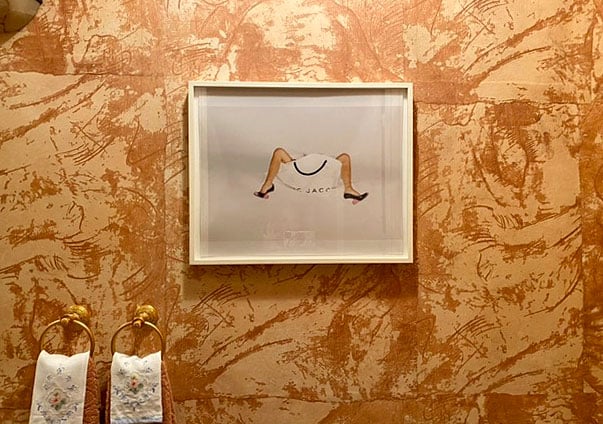
A photograph by Juergen Teller. Courtesy of Roya Khadjavi.
What is the most impractical work of art you own?
A video projection by Jennifer Steinkamp. The projector keeps getting loose from the wall, which I have to keep patching up.
What work do you wish you had bought when you had the chance?
A painting by Tala Madani, a well-known artist whose works command between $250,000 and $300,000, but when she graduated from Yale, her works were only $6,000 to $7,000. I’m kicking myself that I didn’t buy a work back then. Nowadays, her shows are usually sold out before you can even see them.
If you could steal one work of art without getting caught, what would it be?
A painting by Picasso or Rothko.
